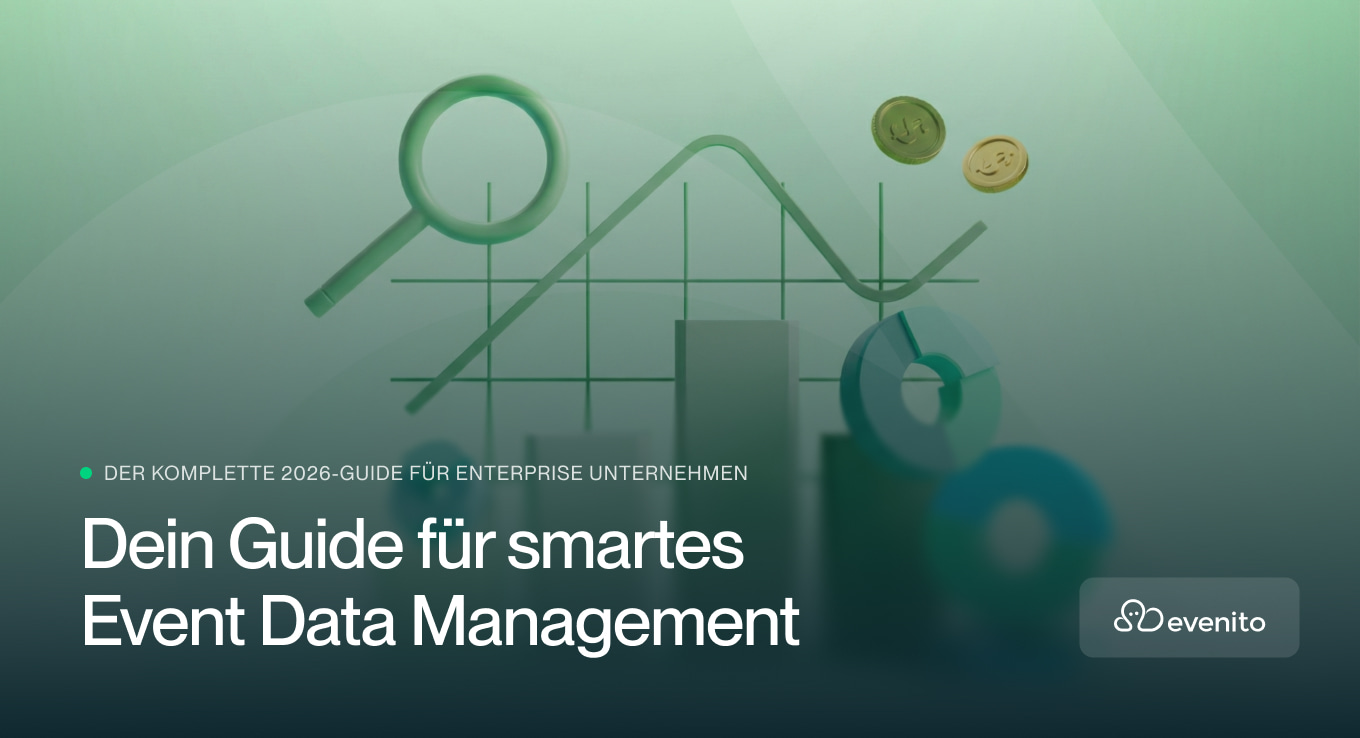Who hasn’t experienced it? The event has just successfully ended and, suddenly, you’re bombarded with questions: How many people attended? What was the rate of no-shows? Who attended the event?
As an event manager juggling multiple events simultaneously, collecting Key Performance Indicators can be a real challenge. Nevertheless, data analysis plays a crucial role in event management, helping to better plan, execute, and measure the success of your events.
In this blog, we focus on the importance of data analysis and interpretation. In addition to tools and methods for data analysis, their application in event planning, and the interpretation of data, we also look at the challenges and future developments in this area.
The right KPIs for event management
What makes an event good? If you ask the participants, the answer will certainly include a nice atmosphere, delicious food and cocktails, and an interesting audience. However, other factors also play a role in event management. We’re talking about Key Performance Indicators (KPIs). KPIs play a central role when it comes to measuring the success and effectiveness of an event. These are quantitative and qualitative metrics that quantify specific goals and performances. By identifying and monitoring the right KPIs, events can be thoroughly evaluated and informed decisions can be made for future events.
The big question is: What KPIs are best for event management?

Registration, attendance and no-show rates
These metrics are likely the most obvious: How many people registered for your event, and how many actually attended? The number of registrations is always set in relation to the number of attendees. The difference is referred to as the no-show rate (people who were registered but didn’t show up).
Networking and output
Collecting data through the registration form also allows for personalised communication with registered participants in the next step of the process. The information collected is stored in the event management software and can be used for subsequent communication.
Especially for events that aren’t focused on parties or concerts but rather on selling a product, networking is a key success indicator. The number and quality of interactions during the event are important metrics in this context. These can be measured by analysing networking event sessions, meeting requests, and connections made on social networks.
Social media engagement, lead generation, and conversions
Event reach can be measured based on social media mentions. These metrics include likes, shares, comments, and hashtag use. In addition to social networks, the event website, newsletter, and event apps provide interesting insights, such as click rates in relation to ticket sales.
For events that aim to generate leads, the number of leads generated and the conversion rate are important KPIs. These metrics measure how effective the event was in attracting potential customers.
Participant satisfaction and Net Promoter Score (NPS)
Participant satisfaction is an essential KPI. Satisfaction can be used to gauge the event’s quality and success as well as derive the Net Promoter Score (NPS). The NPS indicates how likely it is that participants will recommend your event to others.
Invitation response rate
The invitation response rate indicates how many invited individuals actually respond to your invitation and register for the event. This metric helps you assess the effectiveness of your invitation campaign and, if necessary, make improvements in communication and target audience segmentation.
Ticket sales, revenue, and ROI
The analysis of ticket sales and the resulting revenue are also essential KPIs in event management. The Return on Investment (ROI) measures the ratio of profits earned to the costs invested in the event. These metrics help evaluate the financial performance of the event and determine its profitability.
The value of KPIs
Selecting the right KPIs is crucial for measuring success in event management. By monitoring and analysing these metrics, you can gain valuable insights, make informed decisions, and continuously improve your events.
Sound data and metrics also provide a solid foundation to demonstrate the value and success of the event to clients and stakeholders. Keep in mind, however, that every event is unique. The KPIs should be tailored to the specific goals and requirements to achieve the maximum benefit.

Data analysis tools and methods
The review of KPIs has shown that data analysis and interpretation are integral to event planning. With that said, collecting this data is also a task that requires time and personnel resources. Efficiency is key in this regard. It makes sense to use analytics tools and event management software to streamline the process of collecting and analysing event data efficiently.
Let’s look at possible tools and what they can offer:
Google Analytics
Google Analytics is a classic among analytics tools. It provides you with comprehensive insights into the behaviour of website users. In event management, it can be used to analyse traffic on event websites, assess the effectiveness of event marketing campaigns, and track user interactions.
Tableau
Tableau is a leading visualisation tool that makes it possible to present complex data in a simple and understandable way. For example, you can combine data from different sources and create an interactive dashboard to recognise patterns and make data-driven decisions.
Microsoft Power BI
Microsoft Power BI is another powerful tool for data visualisation and analysis. Its advantage lies in the seamless integration with other Microsoft products. It offers robust features for creating reports and dashboards, with the added benefit of real-time data analysis.
Qualitative vs. quantitative data analysis
KPIs and data analysis in event management can be divided into two categories: quantitative and qualitative.
Quantitative data includes metrics such as number of registrations, attendees, and the no-show rate as well as the analysis of ticket sales and ROI. These are all measurable data points.
Qualitative metrics include participant satisfaction and the Net Promoter Score. This type of analysis focuses on non-measurable data, such as feedback, opinions, and participant experiences.
Both approaches are important for creating a comprehensive picture and making sound decisions.
Data collection methods
Common methods for data collection in event management include but are not limited to surveys, observations, interviews, the analysis of social media activities, and website and event app usage.
Event websites, apps, and newsletters often provide directly usable data through integrated analytics features. These include downloads, engagement, duration of stay, bounce rates, and frequency of use.
There are also various approaches for collecting qualitative data. In addition to creating your own surveys, you can also use tools that offer pre-designed and customisable question catalogues.
Strategic planning and budgeting
“If you can’t measure it, you can’t improve it.” – Peter Drucker
This quote from the pioneer of modern management theory, Peter Drucker, highlights how important a strategic approach is in all areas of management. This, of course, also applies to event management.
Every event has a specific goal, target audience, and scope. To perfectly reach your goal, target audience, and scope in the end, strategic planning and precise budgeting are necessary.
By analysing historical data and trends from past events, you can create a blueprint for future events. Budget decisions are, therefore, based on solid data, leading to optimised resource allocation and making it easier to create proposals for potential clients.
Target audience analysis and segmentation
What would an event be without its participants? A very lonely one, for sure. Of course, when it comes to addressing the target audience, it makes a big difference whether you are planning a festival or a business party.
Example: Business event
In this case, the target audience is focused on and defined by its orientation towards a specific business sector. Business events generally follow a similar structure because certain expectations are in place. The data analysis you collect in event management within the business sector can often be applied directly to new events.
Example: Festival
The situation is different when you’re planning a festival. Festivals are typically large-scale events. The more participants you have, the more diverse your target audience becomes. When dealing with a highly diverse target group, segmentation is a worthwhile approach. This means categorising the people you want to reach. Each category of individuals has different needs, communication channels, and perhaps even different budgets. The challenge is to plan your festival in a way that meets everyone’s needs.
Whether it’s a small or large event, festival, or party, by identifying preferences and behaviour patterns from past events, you can better tailor your future events to the needs of the participants. Data analysis software and tools can highlight patterns and simplify the process for determining requirements.
Marketing and advertising initiatives
Marketing and advertising initiatives are the foundation of a successful event. These measures should be well-planned to ensure the investment pays off and the desired effect is achieved. The desired effect is, of course, to attract as many people from the specific target audience as possible to the event and encourage their participation.
Data analysis plays a key role in the planning and execution of marketing and advertising initiatives. By evaluating campaign data and tracking conversions, you can analyse the effectiveness of past marketing strategies. The data collected can then be used to optimise future initiatives.
Data interpretation and measuring event success
Data only becomes valuable when it is interpreted. To avoid getting lost in the maze of numbers, data, and facts, it is best to use intelligent tools and software.
Interpreting event results
The interpretation of collected data is crucial for evaluating an event’s success. This process if particularly efficient when using specialised event analytics software. Intelligent software identifies patterns in the data and draws conclusions based on the event’s goals, budget, and execution.
Success factors and their evaluation
The factors that determine event success vary depending on its type and objectives. However, commonly considered factors include participant satisfaction, goal achievement, and financial profitability.
Feedback and evaluation processes
Numbers alone don’t capture the overall atmosphere of an event. Surveys, feedback forms, and post-event debriefings are common methods for gathering participant opinions and suggestions as well as for analysing the overall atmosphere.

Data analysis challenges and solutions
Data quality and data integration
One of the biggest challenges in data analysis is ensuring data quality and integrating various data sources. Inaccurate or incomplete data can lead to incorrect conclusions. Implementing event planning software and using intelligent technologies can help overcome these challenges.
Data protection and legal aspects
Since May 25, 2018, the word “data” has caused some unease. That’s because this is the day the GDPR came into play. Regardless of the GDPR, handling personal data always requires special care. When collecting event data, certain conditions must be met, including secure storage and processing as well as safeguarding privacy. Clear data protection policies and training are essential in this regard.
Handling large data values
Every event generates a vast amount of data. Attempting to analyse this data manually can quickly lead to a flood of paperwork and cause you to lose your overview of everything. Event analytics and big data technologies, however, offer solutions to efficiently process this data and extract actionable insights.
The future of data analysis in event management
Trends and new technologies
Since the Coronavirus pandemic, the event industry has become significantly more digital. This trend is also evident in data analysis. Instead of sifting through offline records, the trend is moving towards online analysis tools and event management software, enabling the success of event planning to be tracked efficiently and in real time.
Artificial intelligence and machine learning
Artificial intelligence (AI) and machine learning are revolutionising data analysis, and not just in event management. With AI, patterns and trends in large datasets can be identified more quickly and accurately. Machine learning enables the automation of analysis processes and the creation of precise forecasts, significantly enhancing planning and decision-making processes.
Forecast and future developments
The future of data analysis in event management promises exciting developments. Predictions suggest that personalised and interactive event experiences, predictive analytics, and the increased use of virtual reality (VR) and augmented reality (AR) will play an increasingly important role. These technologies offer innovative ways to enhance participant experiences and make events even more successful. Additionally, these digital elements present interesting options for event analysis.
Conclusion
Data analysis and interpretation are indispensable components of modern event management. The goal is to identify best practices and apply them to upcoming events. Despite the challenges, the use of advanced analysis tools and technologies offers immense opportunities to maximise the success of events and shape future developments.


.svg)



